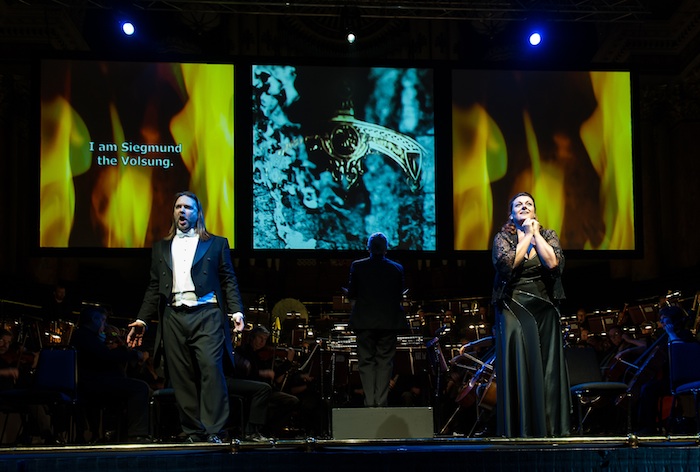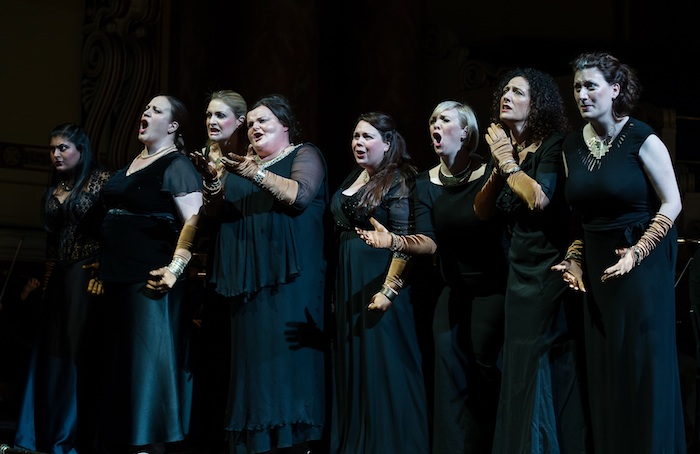This works as well as it did last year – a no-frills approach to Wagner that helps far more than it hinders. Forget fat ladies wearing Viking helmets. Here the intimacy, the surprising humanity of Die Walküre come to the fore in what seems more and more like an opera cycle narrating a complex, tragic family saga, focusing on a father’s inability to control his daughters.
Practical considerations, namely an orchestra pit too small to accommodate Wagnerian forces, have led Opera North to mount their Ring Cycle as a semi-staged production in Leeds’s spectacular Victorian town hall, after which it goes on tour to Salford, Newcastle and Birmingham. As with 2011’s Das Rheingold, Peter Mumford’s staging uses clever lighting and three vast video screens suspended above an augmented orchestra to join the dots - an economical, practical artistic decision that works supremely well. Staging Wagner in a manner that will please everyone is a near-impossible task. These screens fill in the gaps nicely, while the singers can act to varying degrees in front of the musicians.
 A dauntingly long evening flies by – the orchestral playing is world class, and Richard Farnes‘s clear-sighted conducting is a marvel. You hear everything you need to, and the singers are rarely overwhelmed. It’s all beautifully paced, with an extended final scene played with touching sweetness, just at the point where you expect the musicians to be falling off their chairs with fatigue. Die Walküre is a more tender work than its predecessor, Despite the vast forces, the mood is often introspective and chamber-like. The most telling moments are the most human, small-scale ones – Wotan’s discussions with Brünnhilde, or Sieglinde’s exchanges with Siegmund and Hunding in Act One (pictured above).
A dauntingly long evening flies by – the orchestral playing is world class, and Richard Farnes‘s clear-sighted conducting is a marvel. You hear everything you need to, and the singers are rarely overwhelmed. It’s all beautifully paced, with an extended final scene played with touching sweetness, just at the point where you expect the musicians to be falling off their chairs with fatigue. Die Walküre is a more tender work than its predecessor, Despite the vast forces, the mood is often introspective and chamber-like. The most telling moments are the most human, small-scale ones – Wotan’s discussions with Brünnhilde, or Sieglinde’s exchanges with Siegmund and Hunding in Act One (pictured above).
Opera North’s General Director Richard Mantle announced that Annalena Persson, due to sing Brünnhilde, had been laid low by a throat infection. Her replacement, American soprano Kelly Cae Hogan, had flown in from Berlin just hours before the performance. She's a marvel – vocally impressive, impetuous and possessing just enough vulnerability. Her dynamic range is huge, and she looks the part. Her extended scenes with Béla Perencz’s Wotan are electrifying; you’d never guess that the two singers had only just met. Perencz’s Wotan is intriguingly different to Michael Druiett’s portrayal in Das Rheingold. He’s smaller, shiftier, nervier, his body language reflecting his unease at seeing his comfortable existence slowly starting to unravel. His scenes with Katarina Karnéus’s imposing Fricka are exquisitely uncomfortable.
 There are only a few moments when you wish that the singers had the space to behave more credibly. Erik Nelson Werner’s Siegmund can’t help seeming slightly lost without a magic sword to grip on to, and he and his sister Sieglinde (Alwyn Mellor) would preferably edge a little closer together before they embrace at the close of Act One. But the video projections subtly illuminate the drama, as well as providing narration and subtitles. After the ethereal backgrounds of the first opera, Mumford’s opening arboreal shots are fast-moving, claustrophobic, vividly suggesting Siegmund’s panic as he races through the forest. There’s a lot of mud, water, and eventually blood – a pity that more fun wasn’t had with showing different images on different screens at the same time. Flickering flames recur several times, growing in intensity and brightness as Siegmund and Sieglinde declare their love, and glowing brightly in the opera’s final minutes as Brünnhilde lies encircled by fire.
There are only a few moments when you wish that the singers had the space to behave more credibly. Erik Nelson Werner’s Siegmund can’t help seeming slightly lost without a magic sword to grip on to, and he and his sister Sieglinde (Alwyn Mellor) would preferably edge a little closer together before they embrace at the close of Act One. But the video projections subtly illuminate the drama, as well as providing narration and subtitles. After the ethereal backgrounds of the first opera, Mumford’s opening arboreal shots are fast-moving, claustrophobic, vividly suggesting Siegmund’s panic as he races through the forest. There’s a lot of mud, water, and eventually blood – a pity that more fun wasn’t had with showing different images on different screens at the same time. Flickering flames recur several times, growing in intensity and brightness as Siegmund and Sieglinde declare their love, and glowing brightly in the opera’s final minutes as Brünnhilde lies encircled by fire.
All fantastic. But you really need to snap up a ticket for the music. Few of the singers are household names, but none of them disappoints. Wagner’s endless melodies seduce as they unfurl, and the woodwind playing never sours; bass clarinet and cor anglais proving exceptionally impressive. There are no massed anvils in Die Walküre but fans of underused instruments will enjoy a rare chance to hear a contrabass trombone and the steerhorn which blasts out near the end of Act Two. And the Ride of the Valkyries (pictured above), the one moment in the opera where Wagner’s subtlety and good taste seem questionable, is a blast, the melody roaring out on bass trumpet as the eight Valkyries enter one by one and stand in formation. Farnes resists bombast, making the music swagger and soar. Delicious.
Watch the trailer for Die Walküre
- 'Die Walküre is at Leeds Town Hall, then on tour to Gateshead, Salford and Birmingham















Add comment